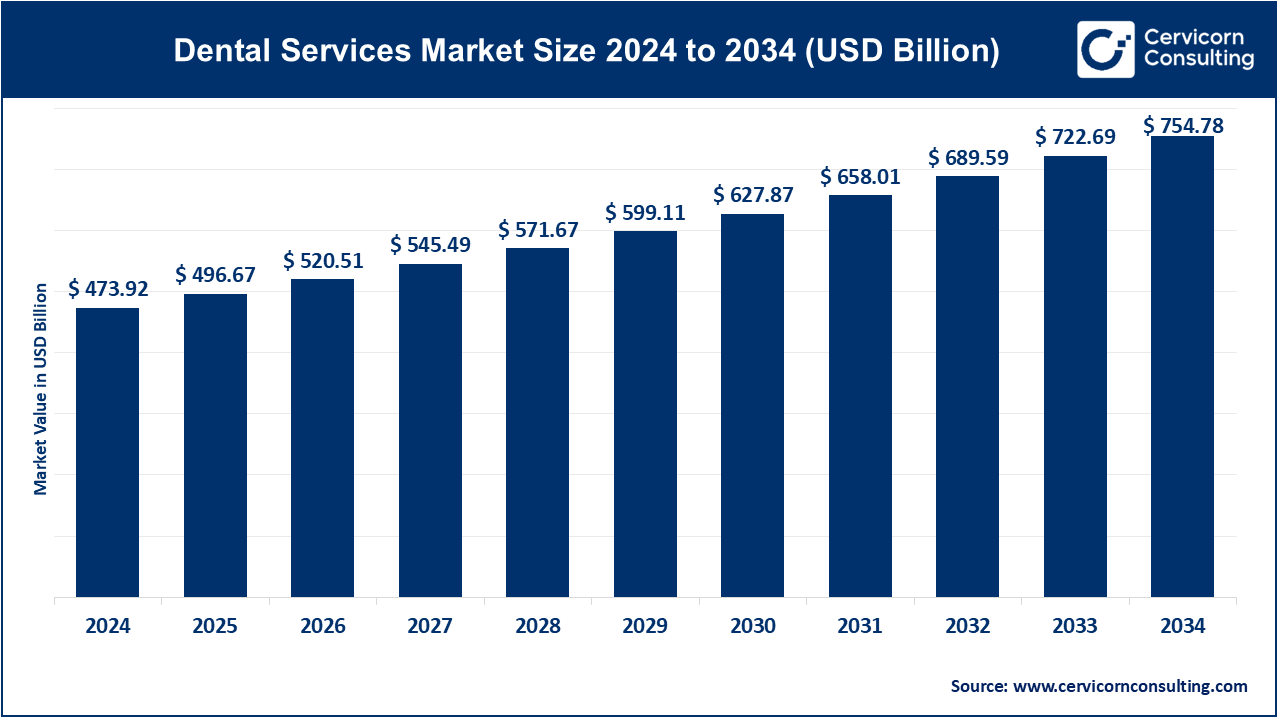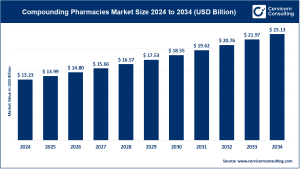Table of Contents
ToggleDental Services Market Size
The global dental services market was valued at USD 473.92 billion in 2024 and is projected to reach USD 754.78 billion by 2034, growing at a CAGR of 4.8% from 2025 to 2034.
What is the Dental Services Market?
The dental services market encompasses a wide range of treatments and procedures aimed at maintaining oral health, preventing dental issues, and addressing specific oral conditions. These services include preventive care, such as routine cleanings, fluoride treatments, and sealants; restorative care, like fillings, crowns, and bridges; and cosmetic dentistry, such as teeth whitening, veneers, and smile makeovers. Other common types of dental services include orthodontics, which involves the alignment of teeth using braces or aligners; periodontics, which addresses gum-related issues; endodontics for root canal treatments; prosthodontics for dentures and dental implants; and oral surgery for tooth extractions and corrective jaw surgeries. Pediatric dentistry also focuses on the oral health needs of children. Technological advancements, such as laser dentistry and digital imaging, are enhancing the quality and accessibility of these services.
Get a Free Sample: https://www.cervicornconsulting.com/sample/2340
Market Trends
-
Technological Advancements
The integration of digital technologies in dental practices is transforming the industry. Tools like computer-aided design and computer-aided manufacturing (CAD/CAM) systems, 3D imaging, and digital X-rays are enhancing diagnostic accuracy and treatment efficiency. These advancements allow for more precise procedures, reduced patient discomfort, and shorter recovery times. -
Rise of Cosmetic Dentistry
Growing consumer interest in enhancing dental aesthetics has increased demand for cosmetic procedures. Treatments such as teeth whitening, veneers, and orthodontic aligners are becoming more popular, driven by societal emphasis on appearance and smile aesthetics. -
Expansion of Dental Insurance Coverage
The expansion of dental insurance coverage and benefits is making dental care more accessible and affordable for a broader population. This trend is particularly significant in regions where dental insurance penetration has traditionally been low, enabling more individuals to seek regular dental care. -
Growth of Dental Service Organizations (DSOs)
DSOs are consolidating dental practices to achieve economies of scale, streamline operations, and improve patient care. The DSO market is expected to grow from USD 404.42 billion in 2024 to USD 1,180.69 billion by 2034, with a CAGR of 11.5%. Consolidation allows for better resource allocation, standardized care, and enhanced bargaining power with suppliers. -
Emergence of Dental Tourism
Countries in Asia-Pacific, the Middle East, and Latin America are becoming popular destinations for dental tourism. Patients from developed countries are seeking cost-effective dental treatments abroad, contributing to the growth of dental services in these regions.
Market Dynamics
-
Drivers
-
Increased Awareness of Oral Health: Educational campaigns and improved access to information have led to a greater emphasis on oral hygiene and regular dental check-ups.
-
Technological Advancements: Innovations in dental technology, such as digital imaging and AI-driven diagnostics, are improving treatment outcomes and patient satisfaction.
-
Aging Population: As the global population ages, there is a higher demand for dental services, particularly in restorative and prosthetic care.
-
Rising Disposable Incomes: Increased disposable incomes, especially in emerging markets, are enabling more individuals to afford dental care.
-
Government Initiatives: Policies aimed at improving healthcare access and affordability are expanding dental coverage and services.
-
-
Restraints
-
Access to Care: In some regions, there is limited access to dental services due to a shortage of professionals and infrastructure.
-
Cost Barriers: High treatment costs can deter individuals from seeking necessary dental care, particularly in low-income populations.
-
Regulatory Hurdles: Varying regulations across regions can complicate the expansion of dental services and the adoption of new technologies.
-
-
Opportunities
-
Tele-dentistry: The adoption of tele-dentistry can improve access to care, especially in underserved areas.
-
Affordable Care Models: Innovative care models, such as mobile dental clinics and community-based services, can address cost and access issues.
-
Policy Support: Government initiatives to expand dental coverage and support workforce development can enhance service delivery.
-
Regional Analysis
-
North America
The U.S. dental services market was valued at USD 153.20 billion in 2024 and is expected to reach USD 248.65 billion by 2034, with a CAGR of 5%. Growth is driven by an aging population, increased public awareness, and technological advancements. -
Asia-Pacific
Asia-Pacific is expected to record the strongest CAGR from 2024 to 2034 due to rising disposable incomes, urbanization, and increasing oral health awareness. Countries like India and China are investing significantly in healthcare infrastructure. -
Europe
Europe holds a significant share of the global dental services market, supported by well-established healthcare systems, high standards of dental care, and a growing elderly population. -
Middle East & Africa
This region presents lucrative growth opportunities due to rising personal disposable income, increasing oral health awareness, and expanding healthcare infrastructure investments.
Recent Developments
-
Technological Innovations
AI-driven diagnostic tools and 3D printing for dental implants are enhancing treatment precision and patient outcomes. -
Consolidation of Dental Practices
DSOs are transforming the dental landscape by consolidating practices, achieving economies of scale, streamlining operations, and improving patient care. -
Government Initiatives
Policies to expand dental coverage and services aim to improve access to care, particularly in underserved areas, and support workforce development.
Conclusion
The dental services market is witnessing significant growth, fueled by technological innovations, increased awareness, and supportive government policies. With the global population aging and rising demand for dental services, the industry is poised for sustained expansion. Stakeholders must adapt to emerging trends, address regional challenges, and leverage opportunities to thrive in this dynamic market.
For more detailed insights, contact us: Contact Us
Read: Compounding Pharmacies Market Size, Trends and Regional Insights by 2034



